Toshiro Saruya
Saruya: Division 28
- Composer: Toshiro Saruya (1960-)
- Instrumentation: Piano
- Work: Division 28
- ISMN:
- Size: 9.1 x 11.8 inches
Description
This is a single piece of music, consisting of 28 parts. in ancient times, in both the East and the West, one way of creating a lunar calendar system to complement the solar calendar was to divide the celestial sphere into 28 uneven segments along the ecliptic or the celestial equator based on the phases of the moon. These segments, as conceived in ancient astronomy, are known in English as the 28 Mansions. They can also be used as reference points for tracking the movement of the moon relative to the fixed stars and to estimate the location of the sun. The origins of this system are said to date back to around 1100 BC, and it is interesting that similar methods were used not only in China, India and Persia, but also in Babylon, Egypt and Greece. Living in the modern age, where almost everything is digitized and ‘evenness' has come to be considered as particularly important, I am intrigued that this system of uneven divisions remains in use in some areas of life today. The idea that 28 is a perfect number may have been recognized by people in many parts of the world throughout the ages. This work is dedcated to Toshi Ichiyanagi, who passed away last year.
Publishers use a lot of words to describe what they sell, and we know it can be confusing. We've tried to be as clear as possible to make sure you get exactly what you are looking for. Below are descriptions of the terms that we use to describe the various formats that music often comes in.
Choral Score
A score for vocalists that only contains the vocal lines. The instrumental parts are not there for reference. Generally, cheaper than a vocal score and requires multiple copies for purchase.
Facsimile
Reproductions of the original hand-written scores from the composer.
Full Score
For ensemble music, this indicates that the edition contains all parts on a single system (there are not separate parts for each player). In larger ensembles, this is for the conductor.
Hardcover
Hardbound. Generally either linen-covered or half-leather.
Orchestral Parts
Similar to a wind set, this is a collection of parts. In the case of strings, the numbers listed are the number of copies included, though generally these are available individually (often with minimum quantities required).
Paperback
When publishers offer multiple bindings (e.g. hardcover) or study scores, this is the "standard" version. If you're planning to play the music, this is probably what you want.
Performance / Playing Score
A score of the music containing all parts on one system, intended for players to share. There are not separate parts for each player.
Set of Parts
For ensemble music, this indicates that there are separate individual parts for each player.
Solo Part with Piano Reduction
For solo pieces with orchestra, this is a version that contains a piano reduction of the orchestra parts. For piano pieces, two copies are typically needed for performance.
Study Score
A small (think choral size) copy of the complete score meant for studying, and not playing. They make great add-ons when learning concertos and small chamber works.
Vocal Score
A score prepared for vocalists that includes the piano/organ part or a reduction of the instrumental parts.
Wind Set
For orchestral music, this is a collection of wind and percussion parts. The specific quantities of each instrument are notated.
With Audio
In addition to the printed music, the edition contains recordings of the pieces. This may be an included CD, or access to files on the internet.
With / Without Fingering (Markings)
Some publishers prepare two copies - a pure Urtext edition that includes no fingering (or bowing) suggestions and a lightly edited version that includes a minimal number of editorial markings.




